Topic outline
-
-
-
Non-renewable resources are natural resources that exist in fixed amounts and can be used up. Examples include fossil fuels such as oil, coal, and natural gas. These fuels formed from the remains of plants over hundreds of millions of years. We are using them up far faster than they could ever be replaced. At current rates of use, oil will be used up in just a few decades and coal in less than 300 years. Continued reliance on fossil fuels as a source of energy is not sustainable. Burning fossil fuels to generate energy also has a huge environmental impact and is a major contributor to global warming.
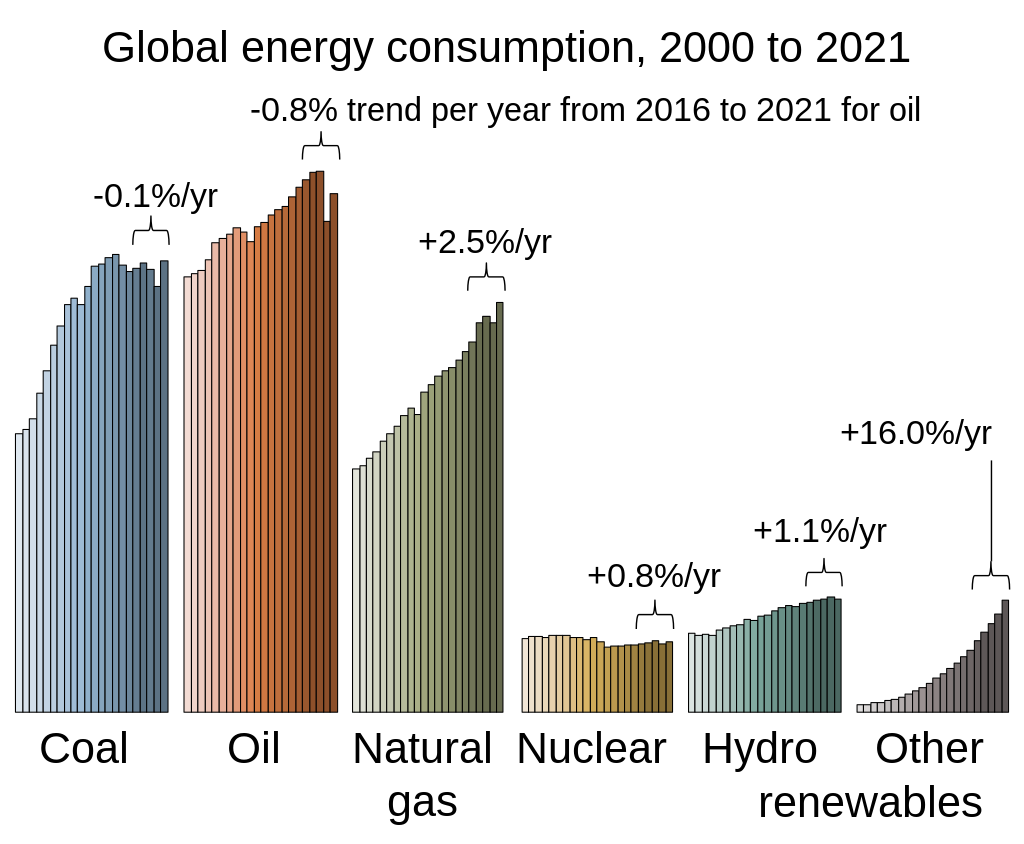
Renewable resources can be replenished by natural processes as quickly as humans use them. Examples include sunlight and wind. They are in no danger of being used up.
Hydroelectric energy is a form of energy that harnesses the power of water in motion, such as water flowing over a waterfall, to generate electricity.
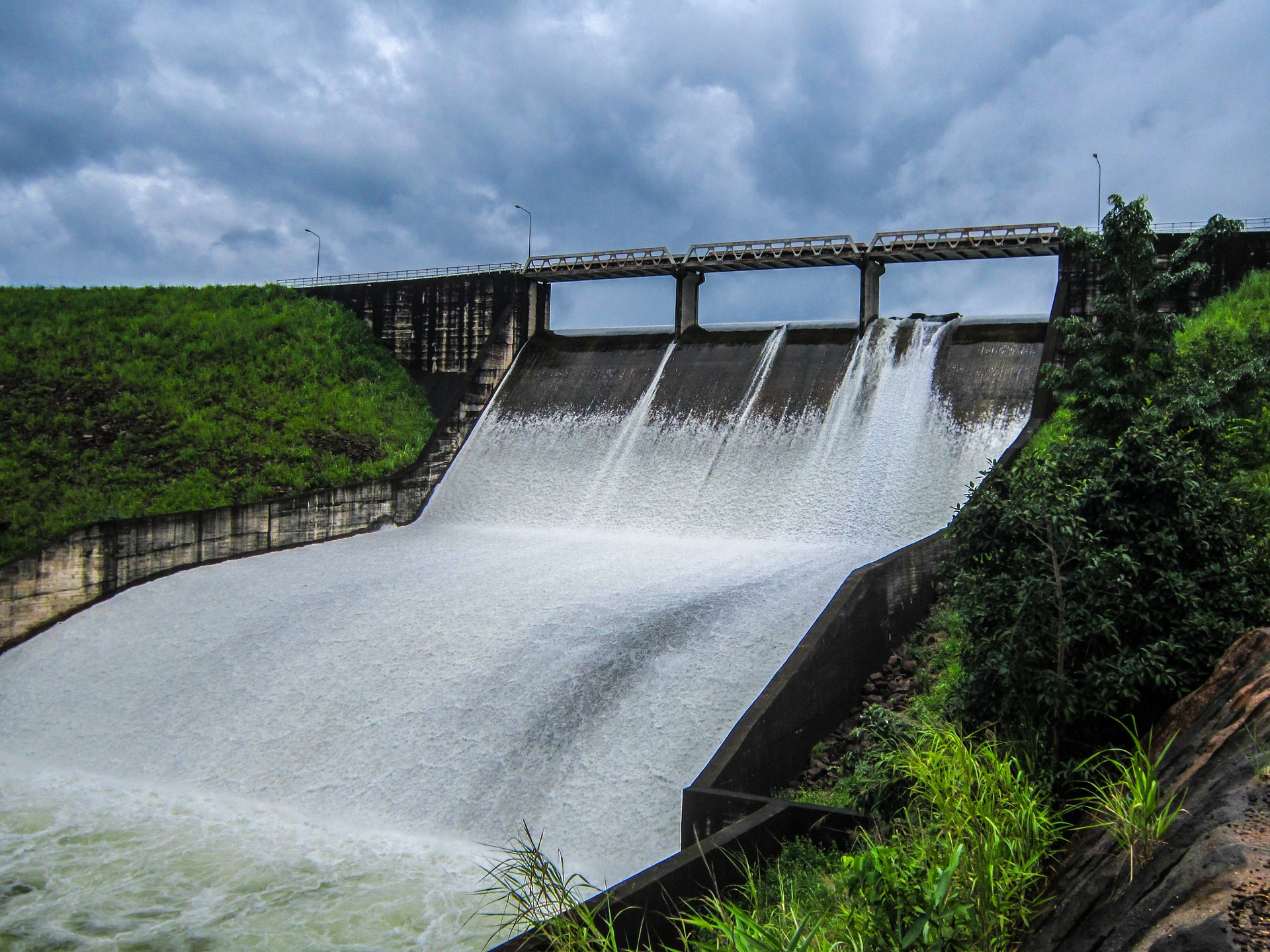
Hydropower (hydroelectric) relies on water to spin turbines and create electricity. It is considered a clean and renewable source of energy because it does not directly produce pollutants and because the source of power is regenerated.
Most types of hydroelectric power plants have a reservoir of water, a gate or valve to control how much water flows out of the reservoir, and an outlet or place where the water ends up after flowing downward. Water gains potential energy just before it spills over the top of a dam or flows down a hill. The potential energy is converted into kinetic energy as water flows downhill. The water can be used to turn the blades of a turbine to generate electricity, which is distributed to the power plant’s customers.
There are three different types of hydroelectric energy plants, the most common being an impoundment facility. In an impoundment facility, a dam is used to control the flow of water stored in a pool or reservoir. When more energy is needed, water is released from the dam. Once water is released, gravity takes over and the water flows downward through a turbine. As the blades of the turbine spin, they power a generator.
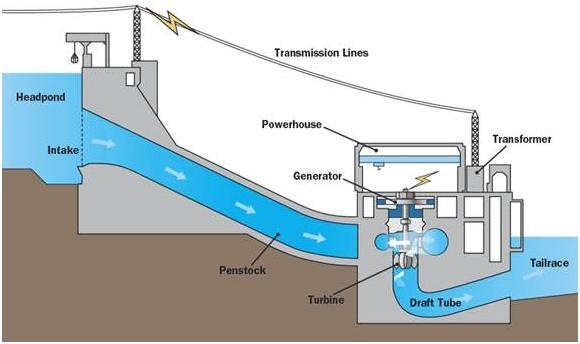
Figure 2: The typical layout of a hydroelectric power plant and its basic components.
Dam and Reservoir: The dam is constructed on a large river in hilly areas to ensure sufficient water storage at height. The dam forms a large reservoir behind it. The height of water level in the reservoir determines how much of potential energy is stored in it.
Control Gate: Water from the reservoir is allowed to flow through the penstock to the turbine. The amount of water which is to be released in the penstock can be controlled by a control gate. When the control gate is fully opened, maximum amount of water is released through the penstock.
Penstock: A penstock is a huge steel pipe which carries water from the reservoir to the turbine. Potential energy of the water is converted into kinetic energy as it flows down through the penstock due to gravity.
Water Turbine: Water from the penstock is taken into the water turbine. The turbine is connected to an electric generator. Kinetic energy of the water drives the turbine and consequently the generator gets driven.
Generator: A generator is mounted in the powerhouse, and it is connected to the turbine shaft. When the turbine blades are rotated, it drives the generator and electricity is generated.
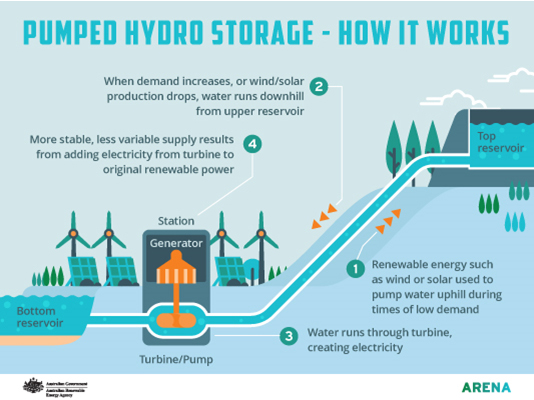
Another type of plant is called a pumped-storage facility. This plant collects the energy produced from solar, wind, and nuclear power and stores it for future use. The plant stores energy by pumping water uphill from a pool at a lower elevation to a reservoir located at a higher elevation. When there is high demand for electricity, water located in the higher pool is released. As this water flows back down to the lower reservoir, it turns a turbine to generate more electricity.
Hydroelectric energy is the most commonly used renewable source of electricity. China is the largest producer of hydroelectricity. Other top producers of hydropower around the world include the United States, Brazil, Canada, India, and Russia. Approximately 71% of all the renewable electricity generated on Earth is from hydropower.
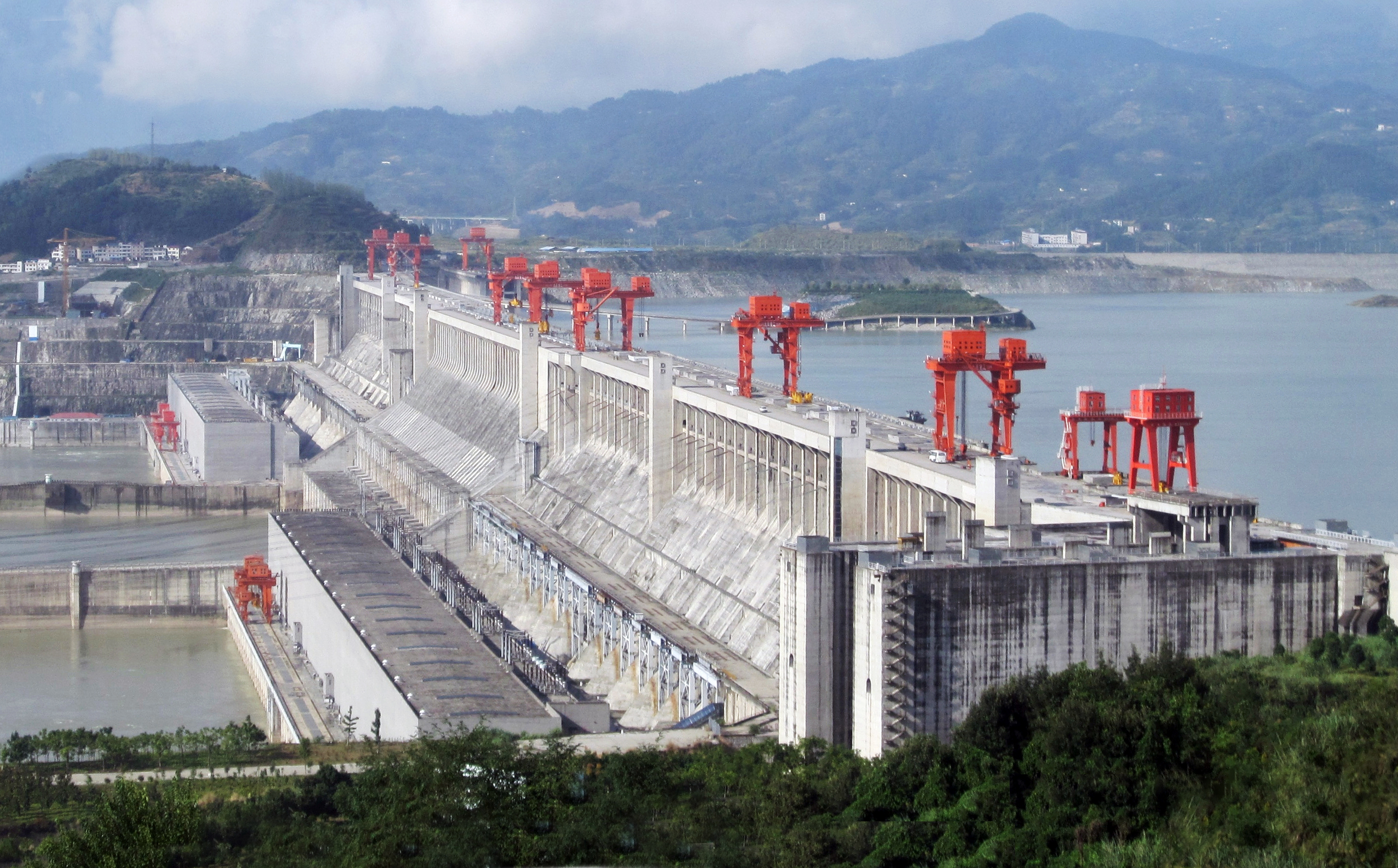
The Three Gorges Dam in China, which holds back the Yangtze River, is the largest hydroelectric dam in the world, in terms of electricity production. The dam is 2,335 meters long and 185 meters tall and has enough generators to produce 22,500 megawatts of power.
Hydroelectric energy is fairly inexpensive to harness.
Rivers flow all over the world, so the energy source is available to millions of people. Hydroelectric energy is also reliable. Engineers control the flow of water through the dam, so the flow does not depend on the weather unless there is a long drought.
However, hydroelectric power plants are damaging to the environment.
- When a river is dammed, it creates a large lake behind the dam. This lake drowns the original river habitat underwater. Sometimes, people build dams that can drown entire towns underwater so people must move to a new area.
- It alters the natural movements of nature: Although modern technology allows for hydroelectric plants to accommodate wildlife movement as best as possible, using salmon runs or alternative migration paths, it isn’t a perfect system. The filling of a reservoir destroys the habitats of certain animal species as well, no matter how careful the construction efforts might be.
- Hydroelectric power plants don’t work for a very long time: Some can only supply power for 20 or 30 years. Silt, or dirt from a riverbed, builds up behind the dam and slows the flow of water.
-
-
-
Sunshine comes close to being the ideal energy source, including widespread availability, an unlimited supply, and zero cost up to the point of collection. Using solar energy does not cause air, heat, or water pollution. Sunshine is intense and widely available in many parts of the world.
There are several ways in which solar energy can be utilised. The simplest of these is for heating water.
Solar water geysers rely on warm water rising, better known as convection. This is how water circulates through the panels. Convection happens when the water stored in the panels heats up and rises into the water tank above, or in the ceiling – depending on where you decide to install it. The hot water in the tank then moves into the cylinder, usually located inside the house.
Meanwhile, the cooler water in the tanks flows downwards into the absorber (collector). These actions create circulation.
Figure 1: Solar water geysers use black tubes to absorb sunlight and heat the water flowing through them.
Heating up of electric water geyser accounts for 40 – 60 % of the household’s electricity
Solar energy can also be used to generate electricity using photovoltaic panels. Photovoltaics (PV), photo meaning light, and voltaic meaning to do with electricity, is rapidly growing with global capacity increasing from 230 GW at the end of 2015 to 890 GW in 2021. PV systems range from small, residential, and commercial rooftop or building integrated installations, to large utility-scale photovoltaic power station.
PV uses solar cells assembled into solar panels to convert sunlight into electricity.
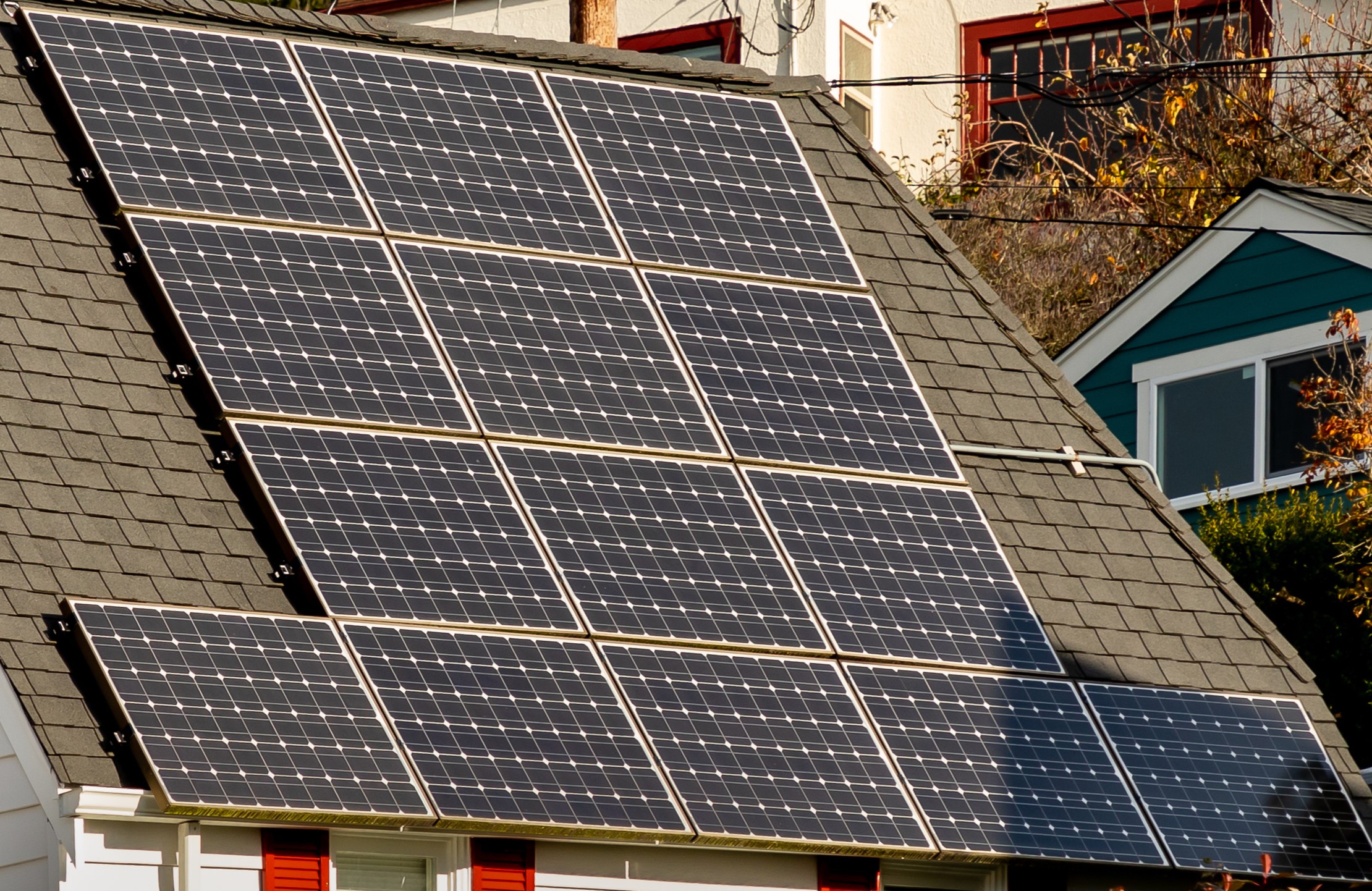
Figure 2: Solar panels on the roof of a house.
Solar cells are small devices which can convert sunlight into electricity. One cell on its own will only provide a small amount of power. Several cells connected and fixed in a frame make a solar panel (or a module), which can produce a larger, useful amount of power. When several panels are connected you have a solar array.
Inside a solar cell there are two wafer-thin layers of silicon crystal, placed on top of each other to make a silicon sandwich. The top layer has been specially treated so that its atoms are unstable because they have too many electrons that they would really like to get rid of.
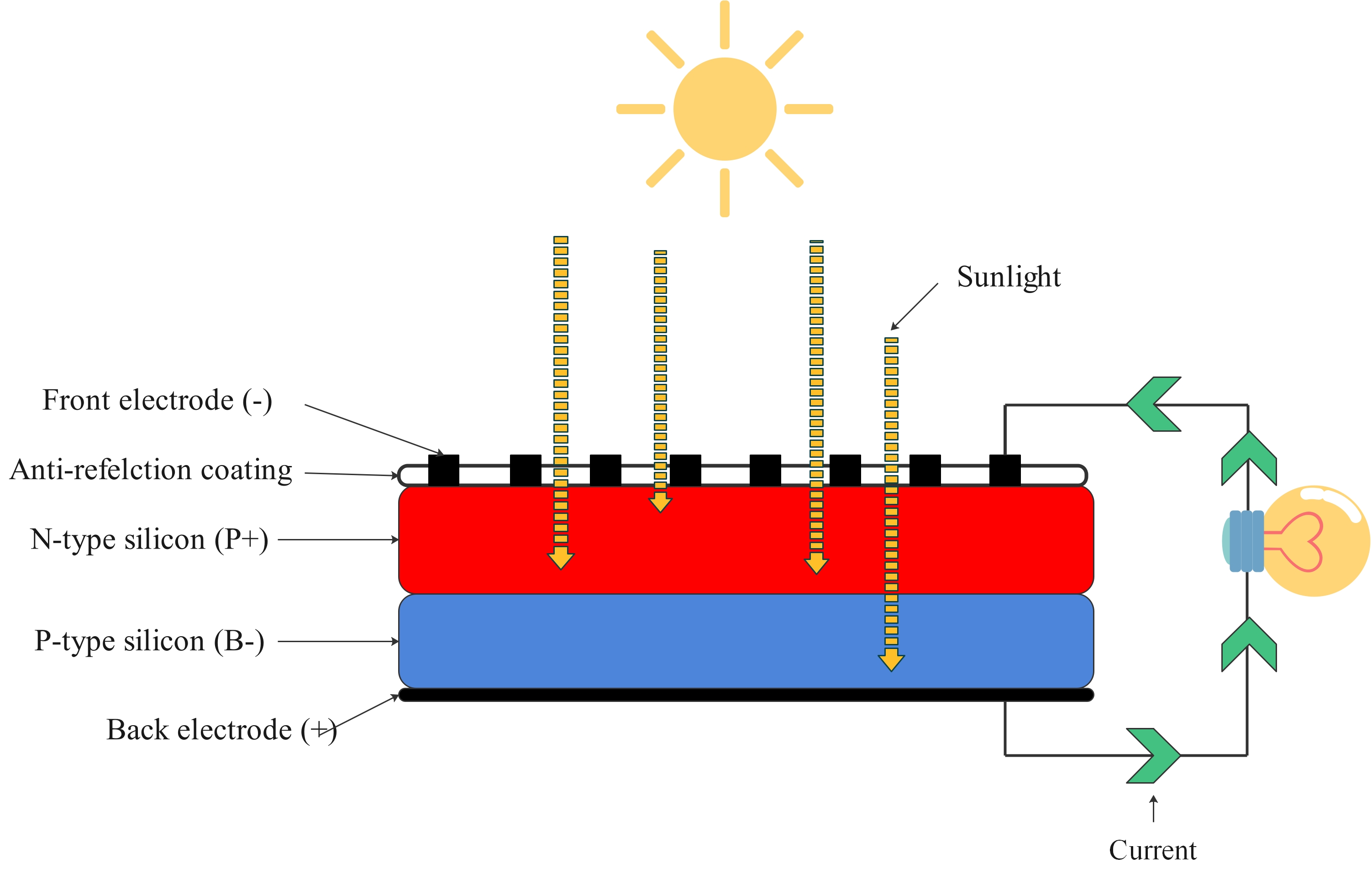
Figure 3: The insides of a solar panel
The bottom layer has also been treated, but the atoms have a few empty spaces that need an electron to fill them. So, the top layer is desperate to lose a few electrons, the bottom layer is desperate to gain a few electrons, and the electrons themselves are itching to move from the top layer to the bottom.
Once the solar panel is exposed to light the electrons within silicon crystal can move around freely.
The inside of a solar cell. As photons of light hit the top layer, it allows electrons to flow from the top layer to the bottom, creating a current.
When sunlight hits the top silicon layer, it ‘excites’ the electrons and gives them enough energy to move. The electrons begin to flow from the top layer to the bottom. When lots of electrons start to move in the same direction, the generate an electric current.
The electricity generated by PV solar cells is DC (direct current). The electricity used in homes is AC (alternating current). So, the current from the solar panel system must go through an inverter, to convert it from DC to AC before it can be pumped into homes and used to run appliances.
Installing solar panels is expensive but in recent years, PV technology has improved its electricity generating efficiency, installation costs have reduced, and it has become a more economical way to generate electricity.
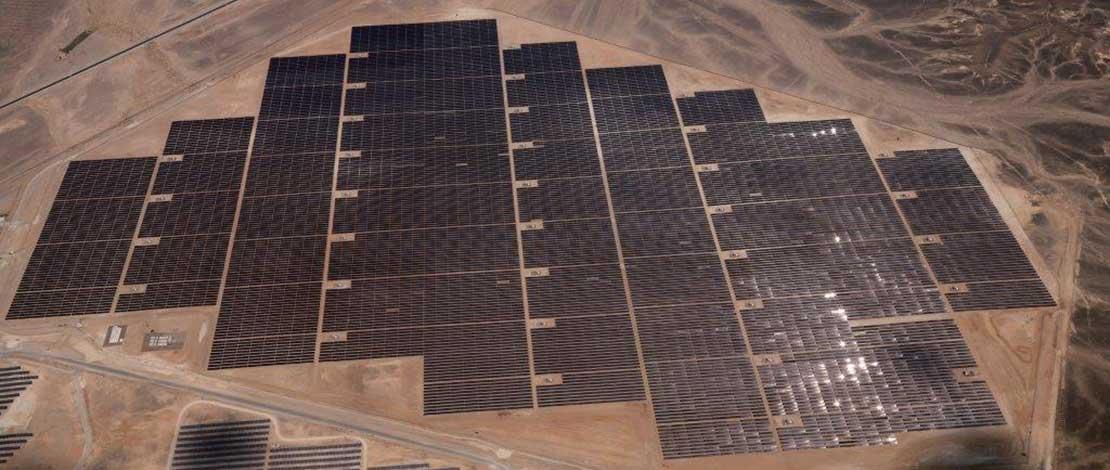
Figure 4: A solar farm in Jordan
China and India are expected to become the world's leaders in using solar energy by 2027. Many solar photovoltaic power stations have been built, mainly in Europe, China and the United States. The worlds 6 biggest farms are:
- Bhadla Solar Park (Rajasthan, India) — 2,245 MW
- Huanghe Hydropower Golmud Solar Park (Golmud, Qinghai, China) — 2,200 MW
- Pavagada Solar Park (Karnataka, India) — 2,050 MW
- Benban Solar Park (Benban, Egypt) — 1,650 MW
- Tengger Desert Solar Park (Zhongwei, Ningxia, China) — 1,547 MW
- Noor Abu Dhabi (Sweihan, United Arab Emirates) — 1,177 MW
Pros of Solar energy
1. Stable price levels compared to other energy sources: Many energies, especially those who rely on fossil fuels, are expensive since a price is usually determined by supply and demand.
2. Cost is zero after one-time investment: Solar energy is free. Apart from the upfront cost for the installation of the solar panels and the storage, energy can be produced with no extra cost.
3. Solar energy is a renewable energy source.
4. Solar power is available all year long and can be stored: Although solar power cannot be produced every day due to clouds or rainfall, the energy that is produced during sunny days can be stored.
5. Solar energy will become even cheaper in the future: Even though there has already been plenty of research in the field of sun energy, it is likely that technological progress will continue, and this will also lead to a decrease in prices for solar panels and batteries.
6. Low maintenance costs and efforts: Since solar panels are quite durable on average, the maintenance costs are quite low.
7. Solar power can be regarded as quite ecologically friendly: Apart from the initial production of solar panels and of solar energy storage, there is virtually no additional pollution associated with the generation of solar energy.
Cons of solar energy
1. Initial production of solar panels produces significant pollution:
2. High upfront costs of solar panels: The upfront costs of solar panels can be quite high as are the batteries needed to store energy.
3. Sun intensity varies over the year: Since there is not only good weather, depending on the region, there might be many days or even weeks with rain or clouds and your solar energy panels will not be able to generate enough electricity.
4. For solar farms, large areas of land must be used, which in turn often leads the destruction of habitats for a variety of animals and plants.
-
-
-
Winds are caused by rotation of the earth, heating of the atmosphere by the sun, and earth’s surface irregularities. Wind is the source of energy for wind power.
Wind has been used for power for centuries. For example, windmills were used to grind grain and pump water. Sailing ships traveled by wind power long before ships were powered by fossil fuels.
Wind turbines are a simple system of generating electricity and haven’t changed much over the centuries.
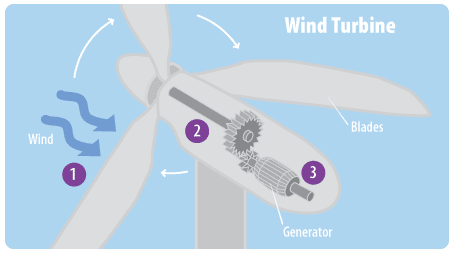
Figure 1: (1) As the wind blows over the blades of a wind turbine, it causes the blades to lift and rotate. (2) The rotating blades turn a shaft that is connected to a generator. (3) The generator creates electricity as it turns.
As the wind rotates the blades – which face into the wind and are tilted to generate the greatest rotation – the blades rotate a shaft and a generator, which turn the energy into electricity. Modern wind turbines will also have sensors which detect the direction and power of the wind, so they can be rotated toward the wind or shut down if the wind is too low, or too powerful.
Crucially, electrical energy is lost if it is transported great distances, so the closer the wind farms are to the grid, the more efficient they become.
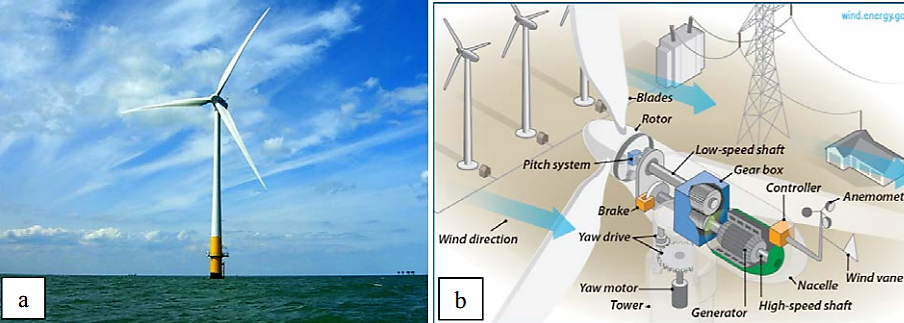
Figure 2: a) This wind turbine in the Thames Estuary in the UK is an example of induction at work. Wind pushes the blades of the turbine, spinning a shaft attached to magnets, see image b for parts. The magnets spin around a conductive coil, inducing an electric current in the coil, and eventually feeding the electrical grid.
Follow the link below, to see an animation of how wind turbines work:
Wind is a renewable resource with wind farms having a near non-existent carbon footprint once the turbines have been constructed.
Figure 3: Many wind farms are located on crop and pastureland.
They contribute to economic sustainability by providing extra income to farmers, allowing them to stay in business and keep their property from being developed for other uses.
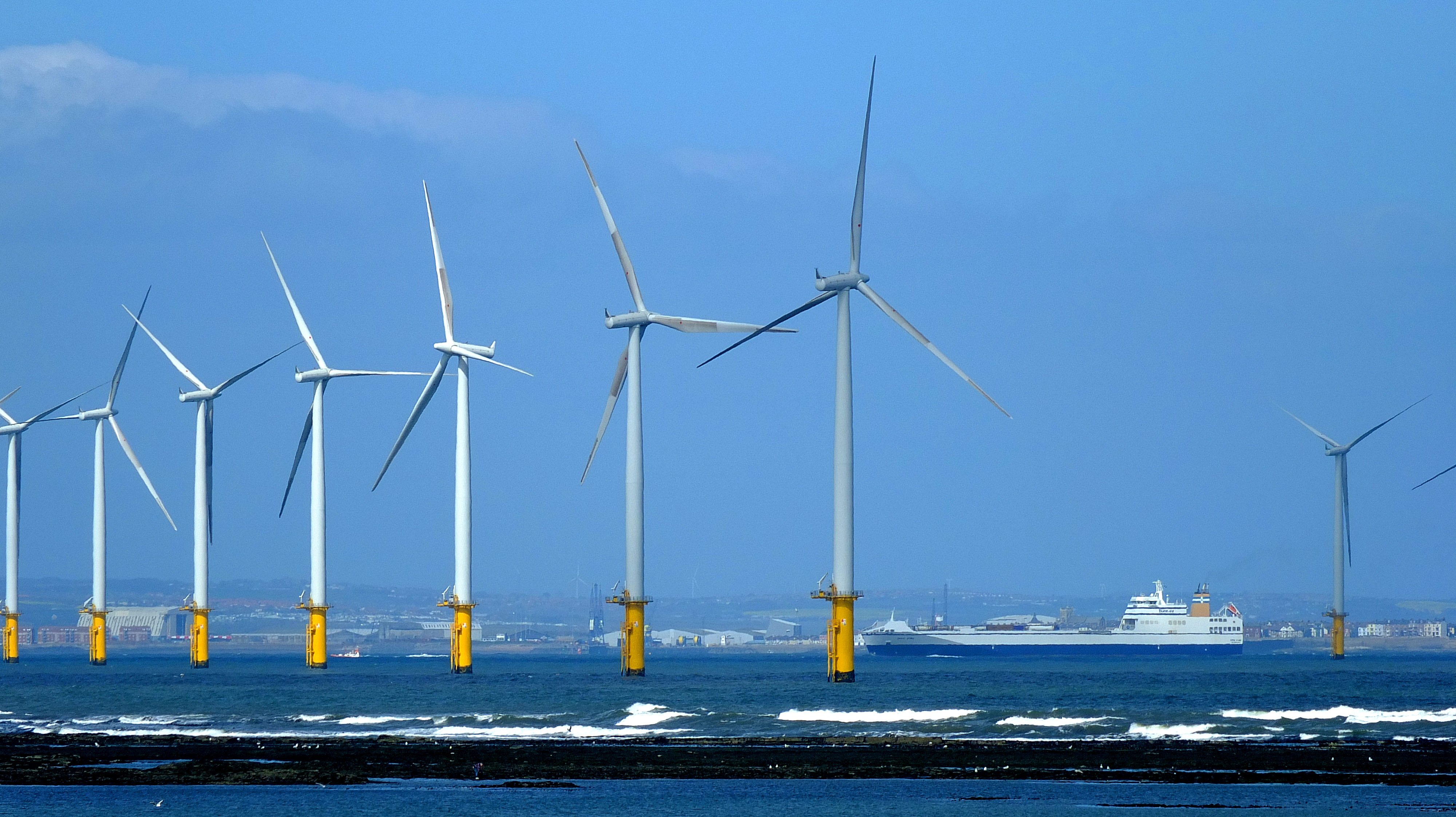
Figure 4: Offshore wind turbines on lakes or the ocean may have smaller environmental impacts than turbines on land, and winds are up to 50% stronger and steadier offshore than on land.
Pros of wind farms
1. Wind Energy is a clean source of power: Wind doesn’t pollute the air or require any destructive chemicals. As a result, wind energy lessens our reliance on fossil fuels.
2. Renewable source: The wind is free.
3. Wind energy has low operating costs: The wind farms or individual turbines can be expensive to install. However, once it is installed and running, operating costs are relatively low; fuel (wind) is free, and the turbines don’t require too much maintenance over the course of their life.
4. Prices are decreasing: Prices of turbines have decreased 1980. Thanks to technological advancements and increased demand, prices are expected to keep decreasing in the foreseeable future.
5. Wind farms can be built on existing farms: Wind turbines are incredibly space-efficient and can be installed on existing farms or agricultural land in rural areas where it can be a source of earning for the farmers as wind plant owners make payments to farmers for the use of their land for electricity generation.
6. Wind energy also conserves water resources.
Cons of Wind Energy
1. Wind Reliability: Wind doesn’t generally blow reliably.
2. Wind Turbines could be threat to wildlife: The edges of wind turbines can be unsafe for wildlife, especially birds and other flying creatures that may be in the area.
3. Wind Turbines could lead to noise and visual pollution.
4. Are Expensive to set up: The manufacturing and installation of wind turbines require heavy upfront investments.
5. Wind power can be harnessed at certain locations only: Wind energy can only be harnessed at certain locations where the speed of the wind is high. Since they are mostly set up in remote areas, transmission lines must be built to bring the power to the residential homes in the city, which requires extra investment to set up the infrastructure.
6. Effect on the environment: Wind farms need wide open areas open area to set up wind turbines and some believe they are an eyesore.
-
-
-
When the wind blows across the surface of the water strongly enough it creates waves. This occurs most often and most powerfully on the ocean because of the lack of land to resist the power of the wind.
Wave energy, also known as ocean energy or sea wave energy, is energy harnessed from the ocean or sea waves. The rigorous vertical motion of surface ocean waves contains a lot of kinetic energy that is captured by wave energy technologies to do useful tasks, for example, generation of electricity, desalinization of water and pumping of water into reservoirs.
When the wind blows across the sea surface, it transfers the energy to the waves. They are powerful sources of energy. The energy output is measured by wave speed, wave height, wavelength, and water density.
The stronger the waves, the more capable it is to produce power. It is not easy to harness power from wave generator plants and this is the reason that they are very few wave generator plants around the world.
Wave power is produced by the up and down motion of floating devices placed on the surface of the ocean. In other words, wind produces waves, and then waves produce energy. As the waves travel across the ocean, high-tech devices capture the natural movements of ocean currents and the flow of swells to generate power.
Terminator Devices
These devices are typically situated perpendicular to the direction of the waves in order to utilize the vertical movement of the surface of the water. In a oscillating water column device, waves push water through an opening below the surface of the device. As the water level within the device rise, the air inside the chamber is compressed and forced out of a turbine to generate electrical power. Oscillating water column devices are most often found on shorelines, but floating systems have been produced as well.
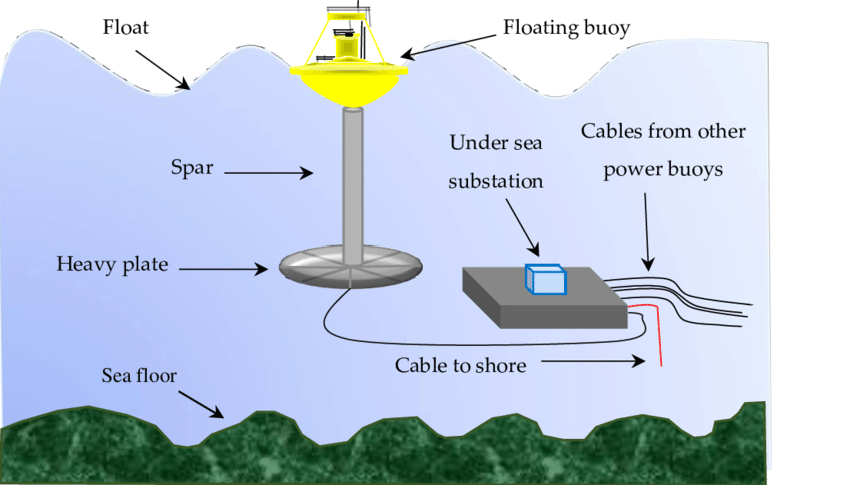
The generator produces electricity, which is transported to electrical grids and later supplied to demand centers and distribution lines that connect individual homes and industries. The advantage of this wave energy converter is that even considerably low wave motions can produce sufficient airflow to maintain the movement of the turbine to generate energy.
Attenuators
Attenuators are long, segmented devices that lie parallel to the direction of the waves. As a wave passes by, different segments are raised and lowered. The motion between segments at differing heights is used to drive hydraulic pumps or some type of converter which can then generate electricity.
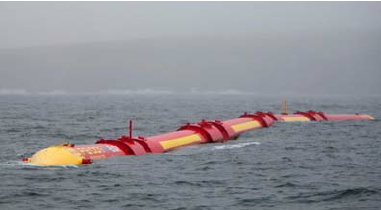
Point Absorbers
These devices use the vertical movement of a floating component to either compress a fluid through a turbine, causing rotational motion that can be used for generation of electricity. They are typically more compact than other devices and require some component to be stationary (mounted to the seafloor) while a complimentary component moves due to the waves.
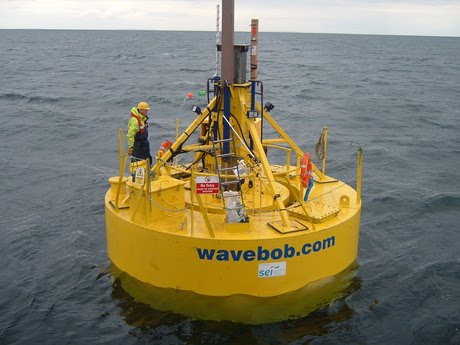
Overtopping Devices
These devices have a reservoir that is filled by incoming waves. As the waves pile up, the water level in the reservoir increases, increasing its potential energy. Much in the same way that a dam on a river does, the water in the reservoir is released through a turbine, and as it flows down into the surrounding water it generates electricity.
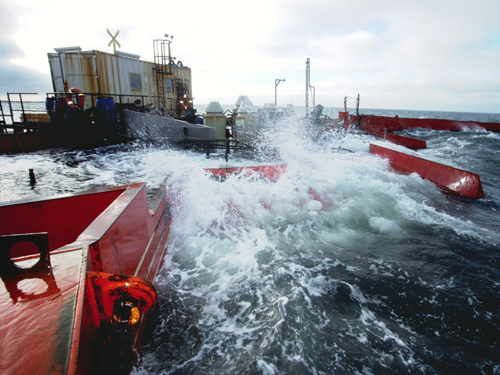
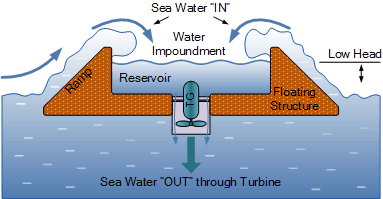
The wave arrival pattern is highly predictable. They arrive day and night and harbor more energy than other renewable sources like wind and solar, but wind speeds die down unexpectedly, which can affect the generation of electricity. The wave magnitude is so unpredictable in the seas. Sometimes it comes vigorously and could cause heavy wear and tear to the wave energy generation turbines. Damage to this equipment can be costly in terms of repair. It would also mean the stalling of electricity supply.
Offshore wave energy projects are sophisticated. The projects include platforms, cables, and turbines. From an ecological standpoint, shallow waters are fertile breeding and resting grounds for most marine life. So, activities from construction and operation of the wave energy plant affect the marine ecosystem. Accidental leaks or spills emanating from hydraulic fluids in the plants could potentially pollute the water resulting in marine life deaths.
-
-
-
Geothermal energy is the heat produced deep in the Earth's core. Geothermal energy is a clean, renewable resource that can be harnessed for use as heat and electricity.
Below the Earth’s crust, is the core. A small portion of the core’s heat comes from the friction and gravitational pull formed when Earth was created more than 4 billion years ago. However, most of the Earth’s heat is constantly generated by the decay of radioactive isotopes.
As these isotope decay, its nucleus changes, emitting enormous amounts of energy. Radioactive decay is a continual process in the core. Temperatures there rise to more than 5000 0C. Heat from the core is constantly radiating outward and warming rocks, water, gas, and other geological material.
If underground rock formations are heated to about 1300 0C, they can become magma. Magma is molten rock permeated by gas and gas bubbles. Magma exists in the mantle and lower crust, and sometimes bubbles to the surface as lava. Magma heats nearby rocks and underground aquifers. Hot water can be released through geysers, hot springs, steam vents, underwater hydrothermal vents, and mud pots. These are all sources of geothermal energy. Their heat can be captured and used directly for heat, or their steam can be used to generate electricity.
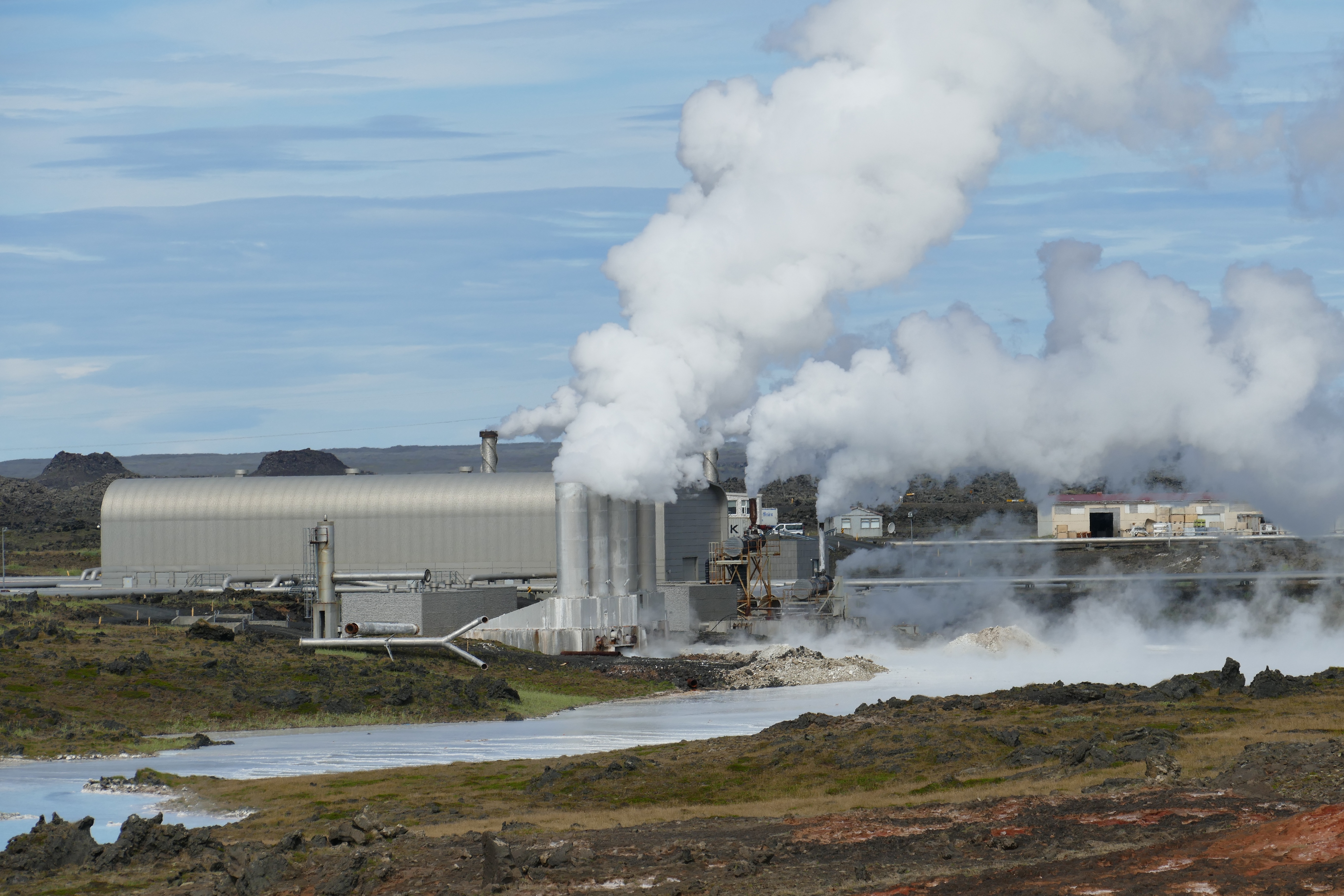
Figure 1: a geothermal power plant in Iceland.
Most of the Earth’s geothermal energy does not bubble out as magma, water, or steam. It remains in the mantle, emanating outward at a slow pace and collecting as pockets of high heat. This dry geothermal heat can be accessed by drilling and enhanced with injected water to create steam.
Many countries have developed methods of tapping into geothermal energy. Different types of geothermal energy are available in different parts of the world. In Iceland, abundant sources of hot, easily accessible underground water make it possible for most people to rely on geothermal sources as a safe, dependable, and inexpensive source of energy.
Almost anywhere in the world, geothermal heat can be accessed and used immediately as a source of heat. This heat energy is called low-temperature geothermal energy. Low-temperature geothermal energy is obtained from pockets of heat about 150° C. Most pockets of low-temperature geothermal energy are found just a few meters below ground. Low-temperature geothermal energy can be used for heating greenhouses, homes, fisheries, and industrial processes.
Geothermal heat pumps (GHPs) take advantage of the Earth’s heat and can be used anywhere in the world. GHPs are drilled about 3 to 90 meters deep, much shallower than most oil and natural gas wells. GHPs do not require fracturing bedrock to reach their energy source.

A pipe connected to a GHP is arranged in a continuous loop that circles underground and above ground, usually throughout a building. The loop can also be contained entirely underground, to heat a parking lot or landscaped area.
Flash-steam power plants use naturally occurring sources of underground hot water and steam. Water that is hotter than 180 0Cvis pumped into a low-pressure area. Some of the water “flashes,” or evaporates rapidly into steam, and is funnelled out to power a turbine and generate electricity. Any remaining water can be flashed in a separate tank to extract more energy.
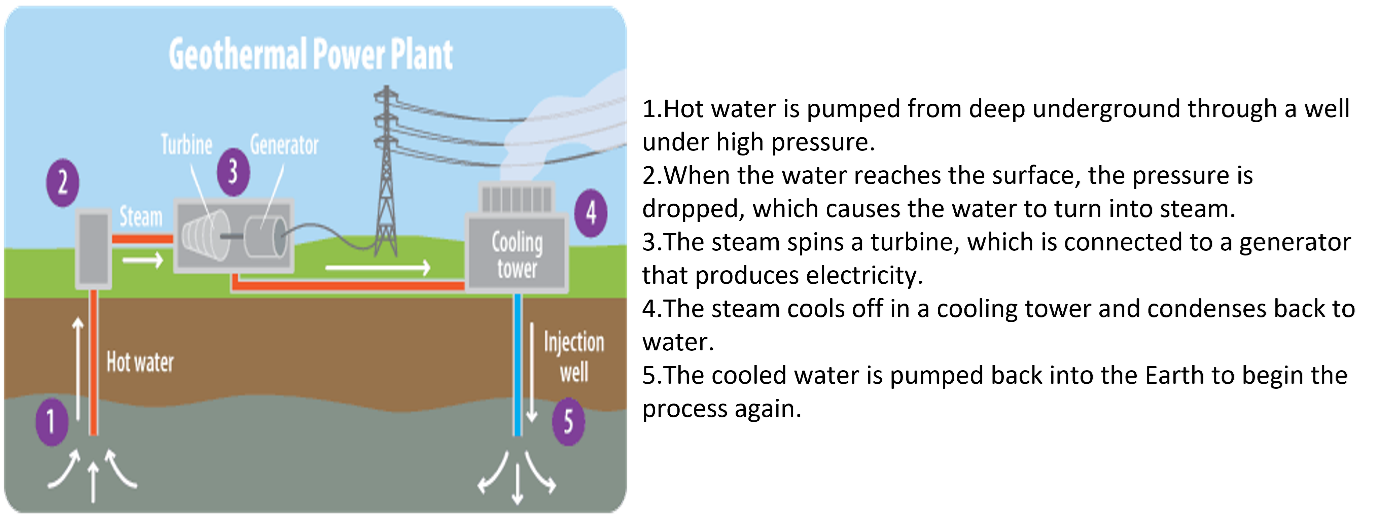
Flash-steam power plants are the most common type of geothermal power plants. The volcanically active island nation of Iceland supplies nearly all its electrical needs through a series of flash-steam geothermal power plants. The steam and excess warm water produced by the flash-steam process heat icy sidewalks and parking lots in the frigid Arctic winter.
Geothermal energy is a renewable resource. The Earth has been emitting heat for about 4.5 billion years and will continue to emit heat for billions of years into the future because of the ongoing radioactive decay in the Earth’s core. However, most wells that extract the heat will eventually cool, especially if heat is extracted more quickly than it is given time to replenish. Geothermal systems do not require enormous amounts of freshwater. Because water is only used as a heating agent and is not exposed or evaporated. it can be recycled, used for other purposes, or released into the atmosphere as non-toxic steam.
Geothermal energy exists in different forms all over the Earth (by steam vents, lava, geysers, or simply dry heat), and there are different possibilities for extracting and using this heat.
-